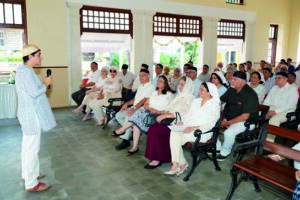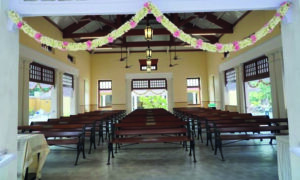 An inauguration ceremony, marking the reopening of the newly refurbished visitors’ pavilion housed within Mumbai’s Doongerwadi (Tower of Silence), for non-Parsi mourners, was organised on 1st November, 2024, by the Bombay Parsi Panchayat (BPP), its managing body. After nearly a year of undergoing extensive renovations, the Panday Pavilion, built in 1928 and named after its munificent donors, witnessed a sizeable gathering of community members on the occasion.
An inauguration ceremony, marking the reopening of the newly refurbished visitors’ pavilion housed within Mumbai’s Doongerwadi (Tower of Silence), for non-Parsi mourners, was organised on 1st November, 2024, by the Bombay Parsi Panchayat (BPP), its managing body. After nearly a year of undergoing extensive renovations, the Panday Pavilion, built in 1928 and named after its munificent donors, witnessed a sizeable gathering of community members on the occasion.
The renovation was financed by donor Zal Eranee, in memory of his wife, Dhun Eranee and executed by Centre for Environment Research and Education (CERE), with architect Kirtida Unwalla heading the restoration team and ecologist Dr. Rashneh Pardiwala, executing the restoration work. One of two seating areas in Doongerwadi open to non-Parsis, the Panday Pavilion and another earlier restored structure, comprise part of Doongerwadi’s precinct listed under Mumbai’s Urban Heritage list, as a ‘Grade IIA’ structure.
 A mix of materials were used in the structure and construction techniques from different construction periods, making it a laborious task. While the exterior is made of basaltic stone, the roof support is made of timber, the roof is made of Mangalore tiles, the columns are made of limestone and the beams are made of brick and concrete. Chandeliers were restored by glass artists brought in from Uttar Pradesh. The flooring, originally made of concrete tiles, was also renovated. A limestone mill had to be installed at the site to create lime plaster for the walls as limestone plastering is not common anymore.
A mix of materials were used in the structure and construction techniques from different construction periods, making it a laborious task. While the exterior is made of basaltic stone, the roof support is made of timber, the roof is made of Mangalore tiles, the columns are made of limestone and the beams are made of brick and concrete. Chandeliers were restored by glass artists brought in from Uttar Pradesh. The flooring, originally made of concrete tiles, was also renovated. A limestone mill had to be installed at the site to create lime plaster for the walls as limestone plastering is not common anymore.
While the two Pavilions have been restored successfully, the larger refurbishment plan aims next at restoring structures across the 50-acre Doongerwadi, which were damaged during 2020’s Malabar Hill landslide.
- જેજે હોસ્પિટલના પારસી વોર્ડમાં નવરોઝની ઉજવણી - 5 April2025
- ઝોરોસ્ટ્રિયન વિમેન્સ એસોસિએશન ઓફ સુરત દ્વારા પાણી બચાવો પર્ફોર્મન્સ - 5 April2025
- આવાં યઝદના પરબની ઉજવણી - 5 April2025
